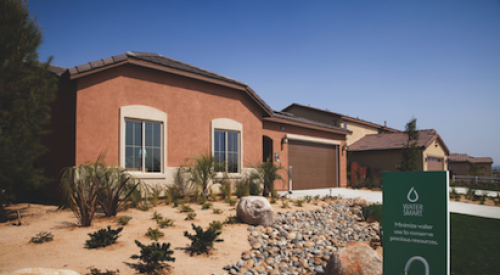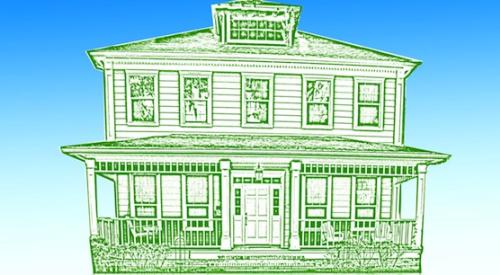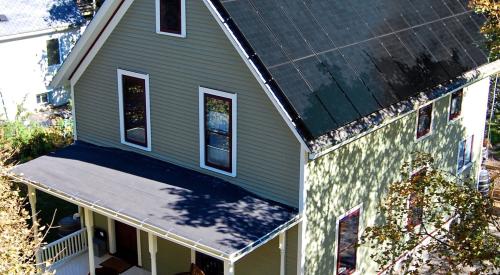|
The myth that green building is only for the super environmentally conscious is dead. Now the myth that green homes are too expensive to build is about to die as well.
Though it's emerging from the fringes, many builders still struggle with how to implement sustainable, energy-efficient, non-polluting building techniques and whether their customers are even interested in green-built homes. And there are builders eager to make the transition yet fear they can't without pricing themselves out of the range of their core buyers.
Still, when forethought is given to site selection, construction processes, features and materials, a green home can be comparable in price to a non-green one. Homes that are energy-efficient, healthy, comfortable and durable are within reach of every home builder's — and home buyer's — budget.
 |
Saving the earth and recycling may not be concerns for home buyers on moderate incomes.
"For a lot of the folks who buy affordable homes, their primary concern is how inexpensively they can get into a home," says Robert Huffman, president of Huffman Homes in Austin, Texas. "That becomes a tougher sell for a green builder. A lot of the very lowest income people do not think of a home as an investment, so it's difficult to justify paying more for a green home."
The fact is if anyone is likely to benefit from owning a green home, it is affordable-home buyers. That's because a green home is well-insulated and energy-efficient, which reduces an owner's monthly heating and cooling costs. A green home uses materials that won't off-gas and pollute the indoor air, which protects the health of the home's inhabitants and cuts down on medical costs. Green homes comprise materials that are renewable and relatively impervious to moisture and the elements, resulting in a more durable home that is easy to maintain, keeping the cost of home maintenance down.
A green home will save its owners money in both the long- and short-term. And bottom line, it will be a better-built home.
"There are people who started the green building movement years ago who wish that instead of calling it green building, they called it better building, because that is what we are actually trying to do," says Armando Cobo, a custom home designer and building consultant in Albuquerque, N.M.
Cobo has designed several homes for Habitat for Humanity through the U.S. Department of Energy's Building America program, a private/public partnership that develops energy solutions for new and existing homes.
Although Habitat for Humanity can build green affordably because of donated or discounted labor and materials, Cobo says the Building America program was designed to make green, high-performance building a practical, cost-efficient standard for all production builders.
"The Building America program was designed to cost somewhere around one to two percent over the normal cost of a house," says Cobo. "The farther along you went into the program and the more understanding you and your subs have, it would be more cost-effective. Once you apply all the benefits of the program and the learning curve is established, it would be either a zero-cost or even cheaper than building before."
If builders market their green homes as healthier, more durable, more comfortable — and more affordable — their customers will understandably be excited about buying these homes.
How Green Are Your Building Values?One factor that affects cost is how deeply a builder decides to delve into green building.
"There are some programs," says Cobo, "like the [United States Green Building Council's] LEED for Homes pilot program, that have as their target the cream of the crop of green homes." Because programs like LEED-H target builders already constructing high-level green homes, novice green builders who adopt these requirements may see costs rise significantly.
"I always temper my green building with the fact that first and foremost the homes have got to be affordable," says Huffman, who participates in Austin's Green Building Program, the first local green building program in the country.
Huffman's philosophy is to implement those green elements that make economic sense — that create a favorable balance between the monthly PITI cost [principal, interest, taxes and insurance] based on the purchase price of the home, monthly utility costs, maintenance and commuter costs (if a home is close to work or school, then less car fuel is used).
 A green home is well-insulated and energy-efficient, which reduces an owner's monthly heating and cooling costs. |
Austin's residential green building program rates homes on a scale of one to five stars — the more green features, the more stars you earn.
"There are some tract builders that achieve one star," he says. "There are several homes, and only several, that achieve a five-star rating. That's really pretty much pulling out all the stops and doing almost everything that you can to make it a very green home. Those will tend to be very expensive homes, simply because they often include photovoltaic systems, super insulation or alternative wall systems, things like that.
"All of our houses obtain a minimum of three stars, and some of them four stars," says Huffman. "So we are in the top one-tenth of one percent of all houses as far as green is concerned. But it requires very selective attention to which elements we put into the house."
Christopherson Homes in Santa Rosa, Calif., is responsible for Mane's Ranch, the first green home development in Sonoma County, Calif. The homes were built in accordance with Santa Rosa's original green building guidelines, which have since become more rigorous.
Amy Christopherson Bolten is the director of community development for Christopherson Homes. Her concern is that building green not add considerably to construction costs in an area with median home prices around $500,000.
"If something was not going to really have any impact, and it costs a lot, we would obviously not adopt that [green element]," says Christopherson Bolten. "We went line item by line item and asked ourselves, is this prohibitively expensive? No. Do we think buyers are going to appreciate this? Is the city going to care about it? If it's a yes for those things, we would probably stick it in our program. So it is a bang-for-your-buck decision."
The Value of "Green by Design"Many elements of green building require advance planning; this becomes even more important when you're on a tight budget.
"The most effective strategies to realize energy efficiency and therefore greater comfort and reduced energy bills are by adjusting the design to respond to the site," says Peter Pfeiffer, AIA, principle of Barley & Pfeiffer Architects in Austin. Pfeiffer designed and engineered the much acclaimed AndersonSargent zero energy house in Frisco, Texas, that won the 2006 NAHB Research Center's Energy Value Housing Award. "People unfortunately seem to be so inclined to go with expensive options to make the house energy-efficient, where the most effective ones are the ones staring them right in the face."
Pfeiffer suggests certain design strategies to save energy and increase indoor air quality of the home without necessarily incurring more costs.
- Orientation of the site. "If the lot faces west," says Pfeiffer, "you make sure you choose a plan that's got a shading front porch or some type of big overhang to minimize the exposure of those windows to the hot afternoon sun if you're in the South. Being cognizant of how your windows are shaded can cut your air conditioning bills in half."
"If you can choose the best lot, you're going to get a better [energy] rating, absolutely," says Rob Sabin, director of research and development for Aspen Homes of Colorado, the NAHB Research Center's 2006 Silver Energy Value Housing Award winner in the affordable cold climate home category. "Our goal has been to deliver a quality house for a whole subdivision. For our future subdivisions, we've worked with the developer in this process, and we've laid out the streets so that there will be a higher percentage of houses that have the correct orientation. That's not thinking six months down the line or a year down the line. That's laying out a whole subdivision." - Install a properly sized air conditioner. "It requires the builder get a professional to size the air conditioning system based on the loads of that particular house," says Pfeiffer. "But if you put in two tons of air conditioning instead of three, there are going to be a few dollars saved."
And homeowners will be healthier.
Get a professional to the size the air conditioning system.
Architect Peter Pfeiffer
"When you have too big an air conditioner," Pfeiffer explains, "it cools down the air so quickly that it doesn't accurately dehumidify the air. It's still sort of sticky, so people turn the AC lower. That's how they get the humidity somewhat under control, but when you get the house too cool, it sets up conditions ... for mold and mildew to grow in the walls.
"The inside surfaces of the walls get to be so much cooler than the outside air that they reach what's called dew point," Pfeiffer explains. "Condensation starts occurring inside the walls. This can happen wherever there's heat and humidity — the South, Baltimore, New York, Chicago, St. Louis — and it doesn't take a whole lot of days [of heat and humidity] for this condition to manifest itself." - Install air conditioning ducts carefully to minimize leaks. "This is much more effective than worrying about buying one of these fancy energy recovery ventilators," says Pfeiffer.
- Build a house that needs less heating and cooling. Again, proper orientation in terms of sun and shading — even the use of ceiling fans or whole house fans — can make this possible. "Then if you've got money left over to burn," says Pfeiffer, "you can look at fancier, higher-efficiency air conditioners."
Using strategies that save money upfront to pay for more expensive green features later in the process is a philosophy Pfeiffer shares with Miriam Landman, a green building consultant and writer.
"I can give several examples of products and materials that hardly cost more or don't cost more," says Landman, "but I find it even more exciting to talk about some of the items that actually create savings. Those can help offset or pay for some of the other green features that might have added cost. That can allow people, in some cases, to even have solar panels on their houses."
Because of the abundance of green building products in the marketplace, most are competitively priced.
"There are a few particular brands that go above and beyond [the average], Landman says, "and those can have a cost premium, but are still not extravagant."
Energy Star rated appliances include refrigerators, dishwashers, washers, thermostats, even ceiling fans.
"Within Energy Star, there is a lot of gradation in terms of highly efficient or just efficient enough to meet the standard," says Landman. "I don't think there is any sort of cost premium."
Aspen Homes uses Dow Foam for exterior sheathing.
"This does two things for us," Sabin says. "One, it creates an exterior drainage plane, and two, it gives some insulation on the exterior of the studs, so you can get the true insulation value between the studs."
Sabin says it's not significantly more expensive.
"The reality is the foam board that we use as the exterior sheathing has a very predictable price," says Sabin. "We use 100 percent [James] Hardie on our exteriors. OSB fluctuates drastically based on the market from one month to the next and from one season to the next. Dow Foam is more predictable. Sometimes it's more; a lot of times it's less. But you can predict your costs over a longer period of time because it doesn't fluctuate as much."
And there are products that save money in the long run. Among comparable products, "We use 100 percent Hardie on our exteriors — not only the siding but the soffit, the trim and everything," says Huffman, "because it has a lower maintenance cost. Instead of having to paint once every three to four years, with a Hardie 100 percent acrylic/latex combination, you can extend that to 20 to 30 years."
Pfeiffer says Hardie Siding is a reasonably priced green building material that is "probably better from a building science point of view than brick, stucco and stone in climates where air conditioning is used a lot."
"It's more of a water shedding product," he says, "where stone and stucco and brick absorb water."
|











